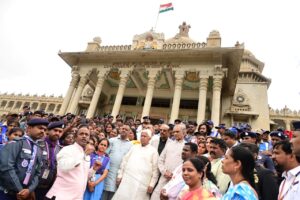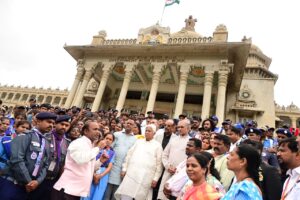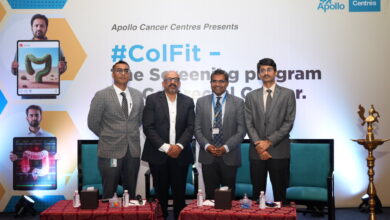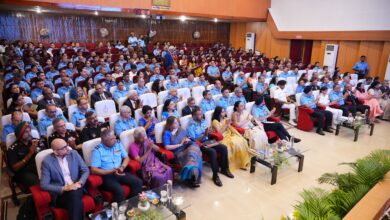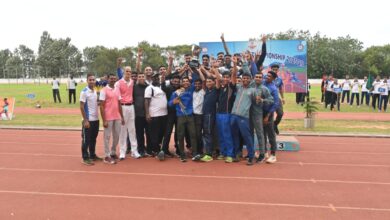Bangalore’s Vidhana Soudha: The Pride of Karnataka
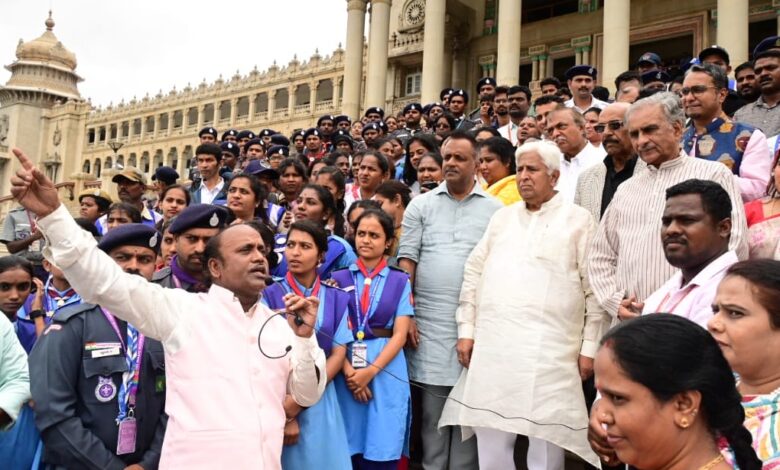
The centrally located Vidhana Soudha in Bangalore is a great reflection of the architectural, engineering, and legislative strength of Karnataka. Not only does this magnificent building serve as the home of the Karnataka state assembly, but it also represents the state’s history and administrative power. Its construction began in 1951 and was completed in 1956. The then chief minister of Mysore (now Karnataka), Kengal Hanumanthaiah, envisioned the idea as he wanted a building that would commemorate the state’s heritage and reputation. The 60-acre building, constructed of granite, is a blend of contemporary, Indo-Saracenic, Rajasthani, and Dravidian style of architecture. “God’s Work is Government’s Work” is its motto, which appears above the entablature and reflects the building’s underlying moral philosophy.
Major Facets of Vidhana Soudha
1. Applied Sandalwood Moral of Vidhana Soudha
There is a distinctive feature at the very core of Vidhana Soudha – an applied sandalwood model. This model is symbolic, not literal, and is the representation of the true spirit of Karnataka’s heritage. Sandalwood, which is a cherished natural treasure of the state, is identified with purity, prestige, and spiritual wealth. The culture of governance of the Vidhana Soudha is compared with the virtues of sandalwood – serene, powerful, and long- lasting. It reminds the legislators gently of their responsibilities towards justice and public well-being.
2. Banquet Hall
The Banquet Hall which is of great importance and is reserved for state functions and sophisticated dinners. There are high profile ministerial meetings and all other international meetings with delegates there. The hall is also furnished with paintings of the former leaders of Karnataka, old style set designs and many other things of historical importance.
3. Assembly Hall
The Legislative Assembly Hall is the epicentre of Karnataka's democratic process. It is where elected members discuss bills, policies, and governance issues of the state during sessions. The hall features cutting-edge communication and voting technologies, while preserving the magnificence of Indian architectural designs.
4. Council Hall
Located just beside the Assembly Hall, the Council Hall is where the Legislative Council, the state’s upper house of the legislature, convenes. It is less spacious than the Assembly Hall, but no less majestic, and is an important part of the bicameral legislative process.
5. Mysore Baagilu
‘Baagilu’ is Kannada for door or gate, and Mysore Baagilu is the large ceremonial gateway of the building. Built in the classic Mysore style, it has carvings with lot of detail, royal crests, and is used frequently during official ceremonies and processions. The gate symbolizes a link with the royal past of the Mysore Kingdom.
6. Chief Minister’s Office
The Chief Minister’s Office is among the most important rooms in Vidhana Soudha. Functionally designed and secure, it is the center of the state’s executive decision-making.
The CM uses this office for holding cabinet meetings, receiving delegations, and governing.
7. Cabinet Hall
The state cabinet discusses significant issues here. With a large conference table and secure communication equipment, the space is intended to maintain privacy and facilitate strategic discussion. It represents the democratic spirit of group decision-making.
8. Committee Hall
The Committee Hall is reserved for meetings of legislative committees, which study specific issues, bills, and government performance in detail. These sessions play a crucial role in legislative scrutiny and policy evaluation. The hall is functional yet maintains the building’s overall grandeur.
9. Bar/Conference Hall
Do not be mistaken as a lounge bar, the Bar Hall is a relic term of British legislative architecture. It is a lounge or meeting space where members can meet informally or attend smaller conferences. The hall is usually utilized for seminars, press conferences, and legislative planning meetings.
10. Grand Stairs
The magnificent stairway of the Vidhana Soudha is one of its most photographed features.
The more than 45 steps leading up to the building’s entrance, which are topped with statues of lions and decorative lampposts, add to its imposing and majestic appearance. The staircase represents the ascent towards justice, law, and governance.
Vidhana Soudha is more than just a government complex; it is a living testament to democracy, local pride, and architectural brilliance. Every one of its halls and chambers fulfills a specific purpose in the administration of Karnataka, and its construction expresses the state’s commitment to cultural heritage and contemporary progress. To visit or read about Vidhana Soudha is to gain a motivating insight into the machinery of one of India’s most dynamic states.
Vidhana Soudha is no longer a distant symbol to admire—it is now a place where the people of Karnataka can walk through the pillars of power and see how democracy works. With the leadership of Speaker U.T. Khader and the tireless commitment of guides such as Gnana Shekhar, this heritage structure is becoming a living classroom of citizenship and civic pride.
A New Chapter: Public Access on Weekends
In a forward-looking effort to take the people closer to the democratic process, the Speaker of the Karnataka Legislative Assembly, U.T. Khader, has opened Vidhana Soudha for weekend public visits. The effort hopes to enhance civic consciousness and enable citizens—particularly students and families—to see the beauty and majesty of the building for themselves.
Tourists can now tread the same corridors where history unfolds, creating a closer link between citizens and their representatives. The initiative has already become a favorite with tourists, teachers, and residents who hitherto could only marvel at the edifice from the outside.
A Guided Experience: Gnana Shekhar, The Parliamentary Storyteller
One of the most important personalities behind this public initiative is that of Gnana Shekher, a veteran guide who has spent more than 25 years with Vidhana Soudha. He is a reliable source of information who narrates the history behind these monuments in the most authentic manner which has undoubtedly gained him recognition among the legislators. His dedication to the storytelling highlights the key role in successfully educating
the visitors. Popular for his eloquent narration and encyclopedic information about the architecture of
the building and legislative processes, Shekhar has been a guide not only for domestic tourists but also for foreign delegates, such as those of the G20 summit. His tours are full of interesting facts, historical facts, and an ardent love for democracy.
Throughout the years, he has taught tens of thousands of schoolchildren and college students, frequently their first exposure to the legislative process of their state. His participation adds credibility and passion to the tours—his words animating stone and statute.
The Minister of Tourism’s Role: The Requirement of a Systematic Service With the growing number of people getting to know Vidhana Soudha, the role played by H.K. Patil, who is the Minister of Tourism, becomes more and more important. He must ensure that this work is done effectively by adopting a reliable and systematic procedure.
While dignitaries and VIP guests can reasonably be given special facilities and concessions, these services should be transparent and operate smoothly. With his leadership, a professional group of trained guides will need to be established and refreshed from time to time so that every visitor—student, tourist, or scholar—is offered an enriching and challenging experience. This will not only preserve the dignity of Vidhana Soudha but also
ensure civic education and people’s outreach become part of Karnataka’s tourism agenda.
